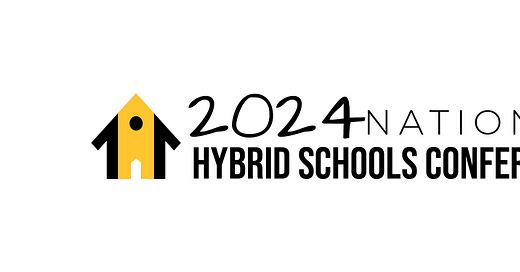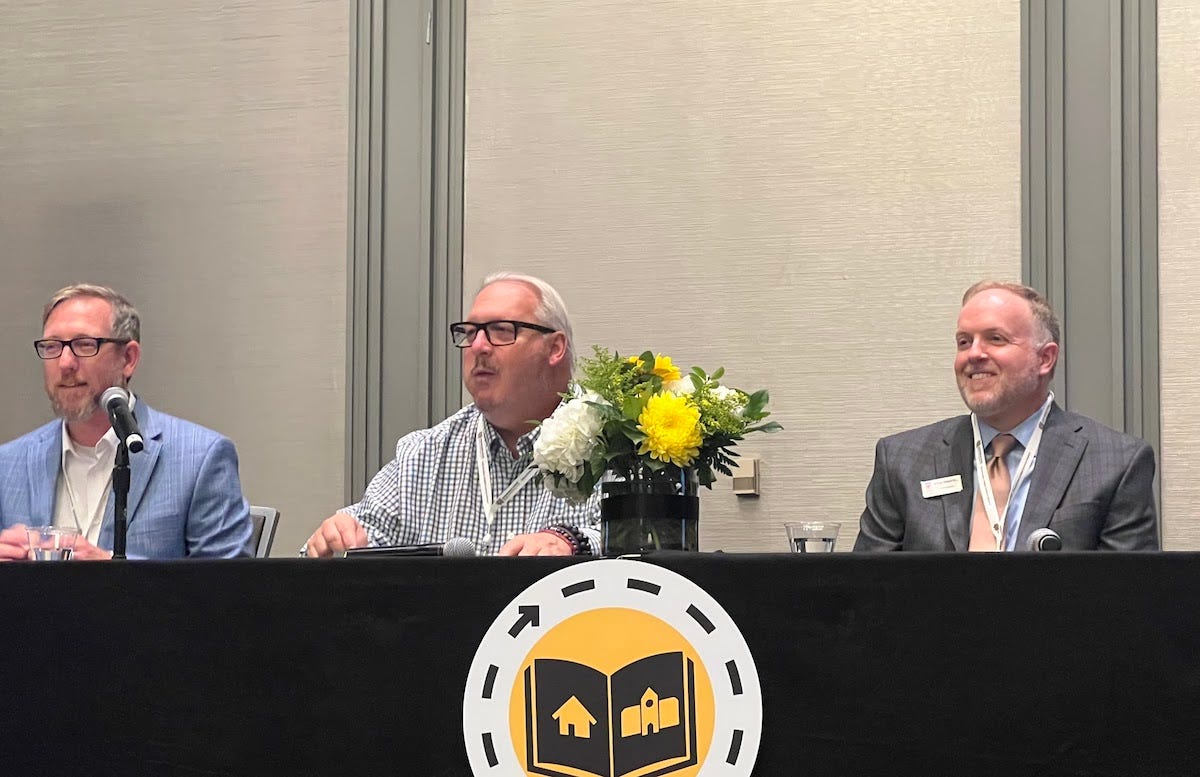A few weeks ago we held the third annual National Hybrid Schools Conference in Atlanta. I then went right into the end of classes and I have finally been able to get through finals and decompress enough to write up some thought on the event. Thankfully, Darien Contu already did a good writeup in Permissionless Education. So did Chris Butler from the Georgia Public Policy Foundation. We solicited session proposals for the first time this year, from members of the Hybrid Schools Society (join here to pitch a session for 2025!) I think this was great; we had a good array of different people presenting, and many of those people could speak to really burning practical issues they had encountered, in terms of policy, accountability, or just blocking and tackling issues like budgeting, hiring, etc. Our keynotes were longtime school founders/leaders Jef and Starrla Fowler from the Veritas School in Austin Texas, sharing their thoughts on how founders can make their schools last beyond themselves. Policy and research are important parts of the conversation, but we talk a lot about practical issues too. See the whole list here.
Our overall theme this year was conversations on “sustainability.” The opening session was titled "The 100-Year School: Sustaining Innovation and Building Legacies in Hybrid Schools." Obviously that was a little bit click-baity; we don’t really expect every school to be functional for a century+. But hybrid and microschools – community crafted schools – rise and fall based on the interest and work put in by their local communities; the practical point I was getting at is: How might we think about sustainability/longevity/succession in these schools?
Our panelists were Shiren Rattigan, founder of Colossal Academy in Ft. Lauderdale, and Robert Randolph from the Family Enterprise Center at Kennesaw State. Robert may sound like an odd fit, but the point of having someone like him was: many, many of these schools really are more like small family business than they are like tech company startups. Here are some of the questions we asked of the panelists:
We know these schools will close at rates higher than conventional public schools (because those never close), or even conventional private schools. That's ok, but if there was just constant churn/school closings, that might not be a better situation for kids and families than what we had pre-COVID. To what extent is this churn of concern to you?
What do you think the biggest threat to the longevity of a hybrid/microschool and/or what's the best thing a hybrid/microschool could do to give itself a chance at longevity?
What did they say about this? Shiren’s remarks were mostly around building a legacy for her own family (a common theme among these schools). Robert had practical advice about why small firms succeed or fail over time. To hear everything they said, check back here in a few weeks when we have the videos posted.
Vibes
Hybrid and microschools – community crafted schools – are all over the map in terms of curriculum, atmosphere. And the political leanings of the families they serve. And this was again true of the people who populated the conference as attendees. This is healthy in a huge, diverse society. We do try to cultivate this feeling at the conference. There is plenty of time to argue over curriculum, but that is better done in bars than in courtrooms. (Now of course everybody has lines they wouldn’t cross. I do too. And of course everybody has ideas about the kinds of school/curriculum they think are best. I do too. But it’s important to keep playing a longer game).
There’s a risk of veering into soulless blandness, or being a corny Pollyanna by going down this road. But I think this is right:
What are the sutures here? Stitches dissolve or fall out. Skin glue dries up and falls off. Sutures aren’t permanent. So after you bring a wound together, it has to bind itself. The law can teach, and laws and state policies can alter behavior over time, sure. But since they’re forced, answers that solely come from the law aren’t very organic. Sometimes those ideas don’t take permanently and the wound reopens underneath. I won’t torture this analogy too far, but maybe the conference itself acts a little bit like a suture. It only lasts a few days, but my hope is people can say things like “Yeah that school over there is CRAZY, but the founder seems nice and their parents have the same kinds of issues ours do.” Or “I would NEVER send my kid to that person’s school, but their board drama sounds pretty familiar to ours.” Or “I can’t believe any one gives THAT school real money. But they did figure out a way to set up a pretty nice building.” If “community crafted schools” comes to mean “progressive woke schools,” then red states will try to hem them in. If it comes to mean “secretly super MAGA Christian schools,” then blue states will go after the few of these schools they currently have.* You win by expanding the constituency for creative school models, and making room for people to choose what they want, not by trying to replicate your own school indefinitely (the country is just too big).
The Close and Next Year
Our closing session was titled "Eccentricity, Authenticity, and Access: Sustaining Innovation and Expanding Reach by Hybrid Schools." Obviously adding the word "eccentricity" is yet more click-bait, but the point here was: How might we think about hybrid and microschools maintaining their identities and creativity, while also coming under more regulatory scrutiny while also getting attention (and maybe direction) from new school choice policies and big philanthropy while also trying to expand access?
Robert Enlow from EdChoice (a national leader), Kyle Wingfield from the Georgia Public Policy Foundation (a state-level leader), and Dalena Wallace (a local expert from Kansas) spoke about questions like:
As things scale, as they get more regulated, as money starts to show up, there is a pull toward selling out. We have seen this kind of thing happen in charter schools. And philanthropy can drive it too. To what extent is this of concern to you?
Since COVID, it seems like these schools have pulled in new families from both sides of the income distribution. The upper end of the income distribution will be fine no matter what we do. How do we expand access to these schools – where often you need adult supervision on homeschool days – to the lower side of the income distribution?
That last question will actually be the theme next year: Conversations on Access, or: How do we get more families to choose community crafted schools?
Thanks to EdChoice and the yes.every kid. foundation and Vela and all of our exhibitors for helping us pull off another winner. You should be there next time!
*But even if either of these did come to pass in some way, these schools aren’t going away. They real ones ignore the outside noise and just keep going, in whatever ways they can. There’s no going back for a whole lot more families and founders now.






